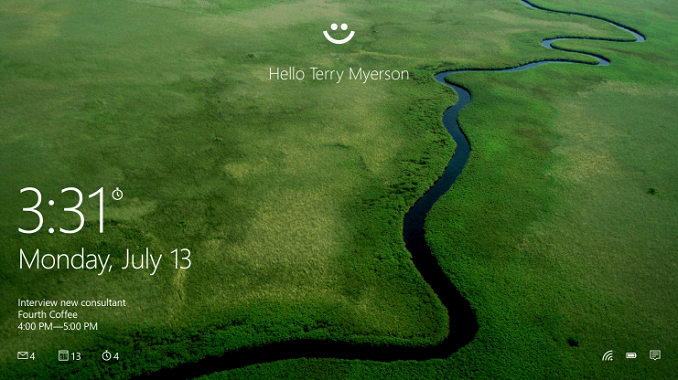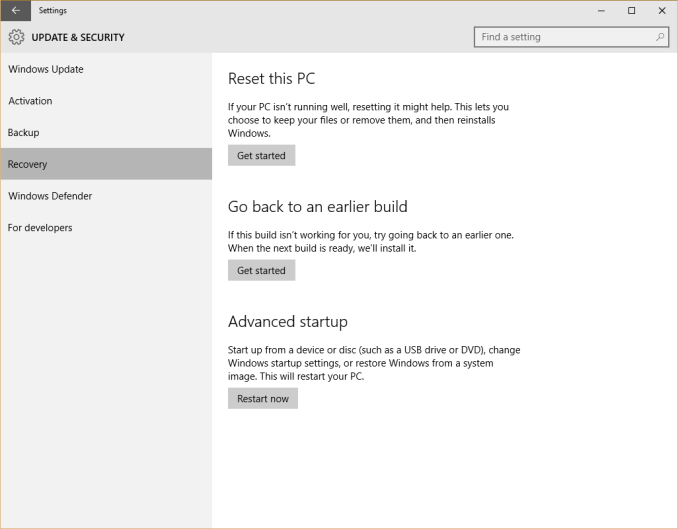Microsoft Confirms You Can Clean Install Windows 10 After Upgrading
by Brett Howse on June 2, 2015 11:10 PM EST- Posted in
- Operating Systems
- Microsoft
- Windows 10

This is one question that a lot of people have been asking, and Gabe Aul, the head of the Windows Insider program, finally answered it on Twitter today. Credit goes to Brad Sams at Neowin for catching this since it was a reply to another tweet.
Gabe states:
Once you upgrade W10 w/ the free upgrade offer you will able to clean reinstall Windows 10 on same device any time
There’s not a lot else to be said, but he also said they are working on some more information to make this more clear. What it does mean is that in order to get the free upgrade, you need to upgrade from an eligible device, and once done, you can then blow that away and do a clean install. I guess we’re not sure yet if that means you can do a reset using the Windows Recovery tools, or if you can actually start with a new hard drive or ISO in order to do the clean install.
Hopefully we’ll get the final bit of clarification on this soon, but since this is one of the most asked questions that I have seen, I felt it was worth letting everyone know.











100 Comments
View All Comments
jabber - Wednesday, June 3, 2015 - link
That was good advice up till Windows XP but not anymore. If you build a PC properly in the first place and watch what you install over time (like we all do here as we are supposedly IT enthusiasts) then a yearly install isn't required. Back in Windows 98 days I would rebuild/install every 3-4 months but now I only do a fresh install if I do a big hardware upgrade or obviously upgrade the OS.Wolfpup - Wednesday, June 3, 2015 - link
Agree completely. Back in the 9x days I used to reinstall every 6 months. Now I never bother with it, unless I'm installing to a new hard drive or installing a new OS (since I really don't trust 'upgrades'). I can't recall having any issues with XP, but for sure I haven't with Vista or newer. My main system running 8 was set up over 2.5 years ago. Although in that case I suppose it was sort of refreshed a bit by virtue of the 8.1 update a year and a half ago or whenever.barleyguy - Wednesday, June 3, 2015 - link
Hardware changes on XP pretty much required a new fresh install. I've seen MAJOR performance problems caused by changing hardware in XP machines, that magically went away with a new install. Probably had something to do with layering of drivers.jabber - Thursday, June 4, 2015 - link
Well if you knew what you were doing it generally wasn't an issue. Some folks just know jack about building a PC properly.All in the layering and order of things.
lilmoe - Wednesday, June 3, 2015 - link
True. I've never faced these "issues" with 7 and above. But you can't ignore all the users who face these problems, and I believe Windows 10's Store model solves that as I said in my reply to gw74.mapesdhs - Saturday, June 6, 2015 - link
Win7 does have its own clogging issues, but they're less severe than XP, at least so far. Over time, check the syslogs, you'll find various errors cropping up, but most are fixable. A few though are really dumb, things like limits in internal management tables being exceeded.lilmoe - Wednesday, June 3, 2015 - link
"windows clogs up over time"The thing I really love about Windows 10 is that you can download all your apps from the Store, even Win32 applications. If you do that, these apps are sort-of sandboxed (while not being restricted like Universal Apps) so that any change they make to the OS (file system, registry, etc...) can be *completely* uninstalled when you uninstall the app. This is simply brilliant and, if done right, will solve the whole clutter problem.
mapesdhs - Saturday, June 6, 2015 - link
Funny how MS will make such a thing out of this notion when it's been standard in UNIX systems for more han 30 years.erple2 - Sunday, June 7, 2015 - link
Heh, dozens of poorly written make uninstall I've used in the past year alone say otherwise. Generally speaking, if the application being installed conforms to the standard package management system for your OS (swinst, rpm, dpkg, are the ones I've had experience with), then they tend to uninstall well, too. Oh, unless you customize a conf file. I suppose any well written uninstaller will do the same. If Microsoft has tightened up the restrictions on a valid installer, then it will be a good thing.grant3 - Wednesday, June 3, 2015 - link
If you have so many "legacy processes" that your computer is slowing down, you should start with the "Add or remove programs" option and get rid of the stuff you installed but no longer want.Windows doesn't "clog up" simply by existing.